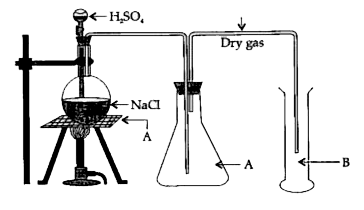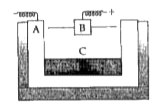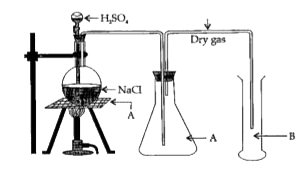Complete Solutions to SECTION - II of chapter SAMPLE QUESTION PAPER -4 of Class 10 book with complete answers and questions
| Class 10 | CHEMISTRY |
| Chapter | SAMPLE QUESTION PAPER -4 |
| OSWAL | SECTION - II |
| Number Of Questions | 85 |
| Academic Year | 2023-24 |
Some properties of sulphuric acid are listed below. Choose the property A, B, C or D which is responsible for the reactions (i) to (v). Some properties may be repeated :
`C_(12)H_(22)O_(11) + nH_2SO_(4) rarr 12 C + 11 H_2O + nH_2SO_4`
View SolutionSome properties of sulphuric acid are listed below. Choose the property A, B, C or D which is responsible for the reactions (i) to (v). Some properties may be repeated :
` S + 2H_2SO_4 rarr 3SO_2 + 2H_2O`
View SolutionSome properties of Sulphuric acid are listed below . Choose the property a,b,c and d which is responsible for the reaction (i) to (v) .
Some properties my be repeated :
(a) Acid (b) Deydrating agent (c ) Non - volatile acid (d) Oxidising agent.
`NaCl + H_(2)SO_(4) to NaHSO_(4) + HCl`
View SolutionSome properties of sulphuric acid are listed below. Choose the property A, B, C, or D which is responsible for the reactions . Some properties may be repeated:
`CuO + H_2SO_4 to CuSO_4 + H_2O`
View SolutionSome properties of sulphuric acid are listed below. Choose the property A, B, C or D which is responsible for the reactions (i) to (v). Some properties may be repeated :
`Na_2CO_3 + H_2SO_4 rarr Na_2SO_4 + H_2O + CO_2`
View SolutionThe following is a sketch of an electrolytic cell used in the extraction of aluminium :
(i) What is the substance of which the electrodes of aluminium:
(ii) At which electrode (A or B) is the aluminium formed
(iii) What are the two aluminium compounds in the electrolyts C.
(iv) Why is it necessary for electrode B to be continuously replaced

View SolutionThe following is a sketch of an electrolytic cell used in the extraction of aluminium :
(i) What is the substance of which the electrodes of aluminium:
(ii) At which electrode (A or B) is the aluminium formed
(iii) What are the two aluminium compounds in the electrolyts C.
(iv) Why is it necessary for electrode B to be continuously replaced

View SolutionThe following is a sketch of an electrolytic cell used in the extraction of aluminium :
(i) What is the substance of which the electrodes of aluminium:
(ii) At which electrode (A or B) is the aluminium formed
(iii) What are the two aluminium compounds in the electrolyts C.
(iv) Why is it necessary for electrode B to be continuously replaced

View SolutionThe following is a sketch of an electrolytic cell used in the extraction of aluminium :
(i) What is the substance of which the electrodes of aluminium:
(ii) At which electrode (A or B) is the aluminium formed
(iii) What are the two aluminium compounds in the electrolyts C.
(iv) Why is it necessary for electrode B to be continuously replaced

View SolutionFollowing is the sketch of electrolytic cell used in the extraction of aluminium :
Name the ore used in extraction of aluminium .

View SolutionCopy and Complete the following table related to electrolysis :

View SolutionDifferentiate between the terms strong electrolyte and weak electrolyte. (stating any two differences)
View SolutionChoose the most appropriate answer from the following list of oxides which fit the description. Each answer may be used only once :
`[SO_(2),SiO_(2),Al_(2)O_(3),MgO,CO,Na_(2)O]`
A basic oxide.
View SolutionCalculate the percentage of Nitrogen in aluminium nitride . (Al = 27,N = 14) .
View SolutionA compound has the following percentage composition by mass: Carbon - 54.55%, Hydrogen - 9.09% Its vapour density is 50. Find the Empirical formula. (H = 1; C = 12; O = 16).
View SolutionDilute nitric acid is generally considered a typical acid but not so in its reaction with metals. Explain ?
View SolutionConcentrated nitric acid appears yellow when it is left standing in a glass bottle. Explain ?
View SolutionExplain the following :
All glass apparatus is used in the laboratory preparation of nitric acid .
View SolutionWith respect to the laboratory preparation of hydrochloric acid answer the following question :
Name the substance A and give its use .
View SolutionWith respect to the laboratory preparation of hydrochloric acid answer the following question :
Which method is used to collect hydrogen chloride gas ?
View SolutionWith respect to the laboratory preparation of hydrochloric acid answer the following question :
Give the reaction which takes place in round bottom flask below `200^(@)C` ?
View SolutionIn the laboratory preparation of hydrochloric acid, HCl gas is dissolved in water.
Write the chemical equations for the laboratory preparation of HCl gas when the reactants are:
(A) below `200^@C` (B) above `200^@C`
View SolutionWith respect to the laboratory preparation of hydrochloric acid answer the following question :
How can hydrochloric acid be prepared from substance B ?

View SolutionName the method used for obtaining ammonia on a large scale .
View SolutionWhat is the actual ratio of the reactants ?
View SolutionThe temperature used is `450^(@)C` . Explain why ?
(A) A lower temperature is not used .
(B) A high temperature is not used .
View SolutionWrite the reaction of sodium with water.
View SolutionAn element X belongs to 3rd period and group II of the periodic table . State :
the number of valence electrons.
View SolutionAn element X belongs to 3rd period and group II of the periodic table . State :
the valency .
View SolutionAn element X belongs to 3rd period and group II of the periodic table . State :
Whether it is a metal or a non - metal .
View SolutionAn element X belongs to 3rd period and group II of the periodic table . State :
Name of the elements.
View SolutionState modern periodic law of classification of elements.
View SolutionAtomic size increases down a group of the periodic table. Explain.
View SolutionGive reason why ?
People suffering from acidity are advised to drink cold milk .
View SolutionGive reasons why :
Sodium chloride will conduct electricity only in fused or aqueous solution state.
View SolutionGive reason why ?
Anhydrous HCl is a poor conductor while aqueous HCl is an excellent conductor .
View SolutionGive reasons for the following :
(i) Methane does not undergo addition reactions, but ethene does.
(ii) Ethyne is more reactive than ethane.
(iii) Hydrocarbons are excellent fuels.
View SolutionWrite balanced equation for the following:
(i) Preparation of ethane from sodium propionate.
View SolutionWrite the equation for the ethene from iodoethane
View SolutionWrite the equation for the laboratory preparation of ethyne (acetylene) from calcium carbide.
View SolutionGive chemical equation for:
The laboratory preparation of methane from sodium acetate.
View SolutionDeifne isomerism.
View SolutionGive the IUPAC name of the isomer `C_4H_10` which has a branched chain.
View SolutionCompare the properties of covalent and electrovalent compounds on the following .
(A) solubility .
(B) Structure .
View SolutionDraw an electron dot diagram to show the structure of hydronium ion. State the type of bonding present in it.
View SolutionSome properties of Sulphuric acid are listed below . Choose the property a,b,c and d which is responsible for the reaction (i) to (v) .
Some properties my be repeated :
(a) Acid (b) Deydrating agent (c ) Non - volatile acid (d) Oxidising agent.
`C_(12)H_(23) O_(11) + nH_(2)SO(4) to 12C + 11H_(2)O + nH_(2)SO_(4) `
View SolutionSome properties of Sulphuric acid are listed below . Choose the property a,b,c and d which is responsible for the reaction (i) to (v) .
Some properties my be repeated :
(a) Acid (b) Deydrating agent (c ) Non - volatile acid (d) Oxidising agent.
`S + 2H_(2)SP_(4) to 3SO_(2) + 2H_(2)O`
View SolutionSome properties of Sulphuric acid are listed below . Choose the property a,b,c and d which is responsible for the reaction (i) to (v) .
Some properties my be repeated :
(a) Acid (b) Deydrating agent (c ) Non - volatile acid (d) Oxidising agent.
`NaCl + H_(2)SO_(4) to NaHSO_(4) + HCl`
View SolutionFollowing is the sketch of electrolytic cell used in the extraction of aluminium :
What is the substance fo which the electrodes A and B are made ?
View SolutionFollowing is the sketch of electrolytic cell used in the extraction of aluminium :
At which electode (A or B) is the aluminium deposited ?
View SolutionFollowing is the sketch of electrolytic cell used in the extraction of aluminium :
What are the two aluminium compounds in the electrolyte C?
View SolutionFollowing is the sketch of electrolytic cell used in the extraction of aluminium :
Why is it necessary for electrode B to be continuosul replaced ?
View SolutionFollowing is the sketch of electrolytic cell used in the extraction of aluminium :
Name the are used in extraction of aluminium .

View SolutionCopy and Complete the following table related to electrolysis :

View SolutionDifferentiate between the terms strong electrolyte and weak electrolyte (any two).
View SolutionChoose the most appropriate answer from the following list of oxides which fit the description . Each answer may be used only once .
`[SO_(2),SiO_(2),Al_(2)O_(3),MgO,Co,Na_(2)O]`
View SolutionCalculate the percentage of Nitrogen in aluminium nitride . (Al = 27,N = 14) .
View SolutionThe Compound A has the following percentage composition by mass : Carbon 26.7% , Oxygen 71.1% , Hydrogen 2.2 %
Determine the empirical formula of A .
(H = 1,C = 12 , O = 16). If the relative molecular mass of A is 90, what is the molecule for of A ?
View SolutionExplain the following :
Dilute nitric acid is generally considered a typical acid but not so in its re action with metals .
View SolutionExplain the following :
Concentrated nitric acid appears yellow when it is left standing in a glass bottle .
View SolutionExplain the following :
All glass apparatus is used in the laboratory preparation of nitric acid .
View SolutionWith respect to the laboratory preparation of hydrochloric acid answer the following question :
Name the substance A and give its use .
View SolutionWith respect to the laboratory preparation of hydrochloric acid answer the following question :
Which method is used to collect hydrogen chloride gas ?
View SolutionWith respect to the laboratory preparation of hydrochloric acid answer the following question :
Give the reaction which takes place in round bottom flask below `200^(@)C` ?
View SolutionWith respect to the laboratory preparation of hydrochloric acid answer the following question :
Why is the temperature of the reaction mixture kept below `200^(@)C` ?
View SolutionWith respect to the laboratory preparation of hydrochloric acid answer the following question :
How can hydrochloric acid be prepared from substance B ?

View SolutionName the method used for obtaining ammonia on a large scale .
View SolutionWhat is the actual ratio of the reactants ?
View SolutionThe temperature used is `450^(@)C` . Explain why ?
(A) A lower temperature is not used .
(B) A high temperature is not used .
View SolutionWrite the reaction .
View SolutionAn element X belongs to 3rd period and group II of the periodic table . State :
Name of the elements.
View SolutionState modern period law.
View SolutionGive reason why ?
The atomic size increases as we move down the group .
View SolutionGive reason why ?
People suffering from acidity are advised to drink cold milk .
View SolutionGive reason why ?
Sodium chloride will conduct electricity only in fused or aqueous solution state .
View SolutionGive reason why ?
Anhydrous HCl is a poor conductor while aqueous Hclis an excellent conductor .
View SolutionGive reason why ?
Ethyne is more reactive than ethane .
View SolutionWrite the equations for the following laboratory perparations :
Ethane from sodium propionate .
View SolutionWrite the equations for the following laboratory perparations :
Ethene from iodoethane .
View SolutionWrite the equations for the following laboratory perparations :
Ethyne from calcuim carbide.
View SolutionWrite the equations for the following laboratory perparations :
Methane from sodium acetate .
View SolutionDefine isomerism.
View SolutionGive the IUPAC name of the isomer `C_(4)H_(10)` Which has a branched chain.
View SolutionCompare the properties of covalent and electrovalent compounds on the following .
(A) solubility .
(B) Structure .
View SolutionDraw an electron dot diagram to show the structure of hydronium ion. State the type of boding present in it .
View Solution
SECTION - II questions and complete solutions for chapter SAMPLE QUESTION PAPER -4 of EVERGREEN CHEMISTRY (ENGLISH) of Class 10